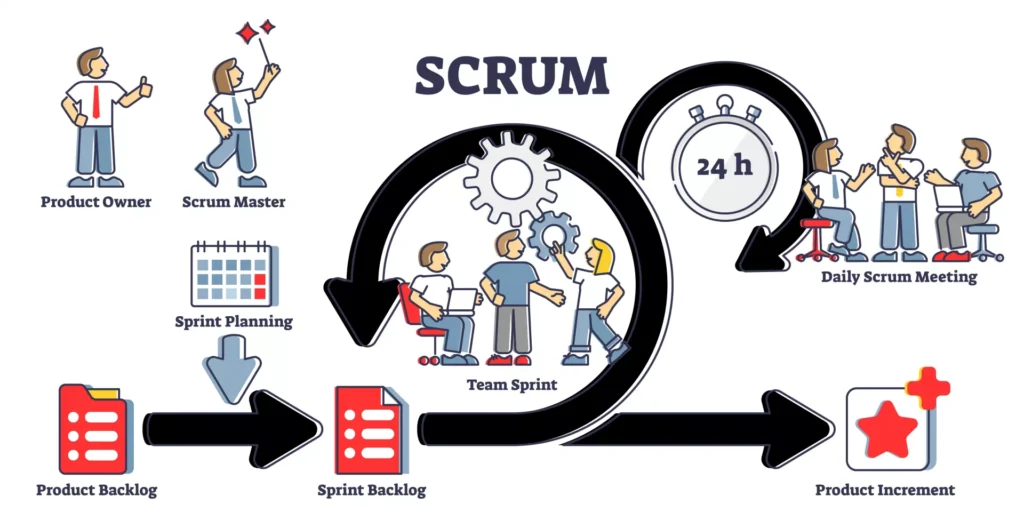At the center of the Scrum process is the ScrumMaster, who plays a crucial role in facilitating and coordinating the various elements of the project. Through their expertise in the Scrum methodology, the ScrumMaster helps to ensure that the project runs smoothly and efficiently and that all team members are working towards the common goal of delivering high-quality results.
To fully comprehend the role of a Scrum Master, it is essential to first understand the concept of Scrum. Originally coined in reference to the sport of rugby, Scrum has also come to signify an agile project management methodology. This method was first introduced in a 1986 paper by Hirotaka Takeuchi and Ikujiro Nonaka titled “The New New Product Development Game.”
This paper became instrumental in the formulation of a scrum as the project management methodology when in 1993 Jeff Sutherland, Ken Schwaber, and Mike Beedle combined the concepts from this paper to formulate the agile methodology now known as a scrum or scrum framework.
What is a Scrum
A scrum in rugby
In the sport of rugby, a scrum is a physical confrontation between two teams of eight players each. It is a structured and coordinated effort, in which each team works together to push the opposing team off the ball. The key to winning a scrum is for all eight players to work together in sync, with a collective effort to push the opposing team over the ball.
Success in a scrum requires teamwork, communication, and coordination, as well as physical strength and endurance. It is a critical aspect of the game, as the team that wins the scrum gains possession of the ball and an opportunity to advance to the opposing team’s try line. In this way, the scrum serves as a microcosm of the game as a whole, where the ultimate goal is to regain possession through a coordinated and collective effort.
It’s important that players use just the right amount of effort, as a scrum is meant to restart play, which means if players exert too much effort, they will have no energy to continue playing, and if they exert too little effort, they will concede the ball and ultimately possession of the ball.

Share on social media
What is a scrum ( in Project Management)
Similarly, in project management, a scrum is made up of a coordinated collection of short sprints (efforts) with the purpose of completing specific tasks, milestones, or deliverables with just the right amount of effort to avoid or reduce waste, but enough to deliver value.
A scrum is a framework that helps teams progress and complete tasks in an efficient manner. This framework provides a structured approach to getting the job done and gives teams the flexibility to come up with their own customized processes.
Although Scrum is often times confused as being Agile, scrum was initially not considered part of the agile methodology. The agile methodology was formulated in 2001 in Utah when 17 technologists drafted the Agile Manifesto. Initially, the Agile methodology, set out in the “Manifesto for Agile Software Development,” focused on 4 key principles that served as the criteria for development frameworks to be considered Agile techniques.
The scrum framework initially was developed based on the lean principle, which described a system’s methods of improving productivity by eliminating waste. As proponents of the lean principles turned their focus to customer collaboration, eventually more agile practitioners came to accept lean methods as agile methods.
A scrum in project management is a series of events in the process of delivering a project or product, with the goal of reducing waste and working efficiently together to deliver value based on customer feedback. These events include :
1. Product Backlog
During the product backlog meeting the stakeholder, product owner, and scrum master discuss all the required features/products/deliverables for the project.
2. Sprint Planning
During the sprint planning, the development team checks out the product backlog and decides what they can achieve and how long it will take them.
3. Sprint Backlog
The items selected by the development team now become the sprint backlog.
4. Sprint
A sprint is a predetermined period of time where team members execute the features selected in the sprint backlog.
5. Standups
During a sprint, the scrum master will dedicate a short amount of time, usually around 15 minutes, to allow members to clear up bottlenecks and update on their progress.
6. Sprint Review
A sprint review takes place after each sprint and allows team members to demo and present their work to the stakeholders.

Roles in a scrum
In rugby, players exert tremendous force on to one another and the referees are responsible for ensuring this takes place as safely as possible by instructing the players to “Crouch, Bind and Set” thereby ensuring everyone is on the same page.
A scrum master can be compared to a referee in that a Scrum Master is responsible for keeping the sprints moving along smoothly, removing obstacles, and mediating discussions. They also advocate for the team and negotiate with external parties. Most importantly, they serve the team.
On both sides of the teams, you have coaches, both serving the interest of their players and their team. In project management, the stakeholders are the ones responsible for the interests of the customer, whereas the product owner is responsible for the interests of the company (maximizing the value delivered by the team).
What is a Scrum Master?
Sticking with the rugby analogies, a Scrum Master is the referee of the project, tasked with enforcing the 4 major principles of the agile manifesto :
Individuals and interactions over processes and tools: A Scrum Master has to ensure an effective and productive working environment by prioritizing individuals over processes.
Working software over comprehensive documentation: Ensure teams are spending time on delivering working products instead of wasting time and resources.
Customer collaboration over contract negotiation: ScrumMaster is there to ensure that the customer’s interests are prioritized above all others by engaging the customer to ensure that the final product reflects the customer’s desires.
Responding to change over following a plan: A ScrumMaster has to be willing to be open to changes as a result of a product coming to life and requiring a different approach than initially determined on paper.
How do you become a scrum master?
According to the website, Zippia, at least 71% of U.S. companies are now using Agile and scrum is the most popular Agile framework, with 61% of respondents from 76 countries reporting that they use it.
With the rapid adoption of agile principles and subsequently the scrum framework, the demand for ScrumMasters is evident. ScrumMasters does not have to be just ScrumMasters though. Scrum Masters can be project managers, a coach, cheerleaders, or even a disciplinarian. But not all of these can be a ScrumMaster. To be a ScrumMaster you need to be able to work with people and let people guide you. The key part of being a ScrumMaster is learning to trust your team members.
Some traits a ScrumMaster should have include :
- Collaborative
- Humble
- Knowledgeable
- Committed
ScrumMaster Training
Once you have decided you have the traits necessary to become a ScrumMaster, you need to decide if you want to become certified as a ScrumMaster. The other option, if you are already in an organization where you can fulfill a role as a project manager, is to equip yourself with the necessary skills with MPUG’s ScrumMaster Training resources.
There is no one best way to learn how to become a ScrumMaster, but there are some essential topics you will need to understand.
- The basics of agile and scrum, including the values, principles, and framework of these approaches.
- The roles in a scrum team, include the scrum master, product owner, and development team.
- The scrum events, including sprints, sprint planning, daily stand-up meetings, sprint review, and sprint retrospective.
- Techniques for effective agile planning, estimation, and collaboration.
- Strategies for facilitating team communication and collaboration, as well as for removing obstacles and ensuring that the team remains focused on its goals.
- The role of the scrum master is coaching the team and the organization, and in promoting the adoption of agile and scrum practices.
Getting Certified as a Scrum Master
While there are many Scrum Master training courses available, not all of them are created equal. Lets take a look at some scrum master certifications
Certified Scrum Master
According to a report published by Coursera in 2022, the Certified ScrumMaster (CSM) certification by scrum alliance is the most in-demand ScrumMaster certificate. The CSM certification is the oldest ScrumMaster certification, having been around for almost 20 years.
The Certified Scrum Master (CSM) course is a good introduction to the world of Scrum for those who are new to it. The course covers the basics of Agile and Scrum and provides an overview of how to implement them. However, it is not intended to give you the skills and knowledge necessary to become a Scrum Master or implement Agile projects.
Disciplined Agile® Scrum Master (DASM) Certification,
PMI, the world’s leading project management institute has also introduced the Disciplined Agile® Scrum Master (DASM) Certification,
DASM is a great choice for anyone looking to learn about Agility, which goes beyond Scrum and the Scrum Master. DASM covers a wide range of topics that are relevant to your business in the current context and in the future.
Not only will DASM introduce you to the world of Agile, including Scrum, but it will also provide you with the tools and resources you need to implement Agility for your team and organization. Thanks for everything, DASM!
Learn how an MPUG Membership helps individuals and teams become better project managers and Microsoft Project users through Microsoft Project Training.
Join MPUG to attend live training webinars, access 500+ hours of on-demand sessions, receive certificates of completion and earn the Project Management Institute (PMI)® Professional Development Units (PDUs) that you need. Watch an MPUG training webinar for free and improve your Microsoft Project skills in less than 1 hour.
Some pitfalls to avoid as a ScrumMaster
Adopting a SCRUM approach can be useful for many organizations. While it requires each team member to provide an update on their work, sometimes this creative writing can become forced when doing it on a regular basis. Fortunately, with proper oversight from management, SCRUMs can be productive and beneficial to teams.
Things to remember as a scrummaster
- For optimal efficiency, plan to tackle small projects in brief intervals.
- Make sure to maintain regular conversations with your fellow coworkers regarding your progress and what needs to be done.
- Everyone is responsible for doing their part and honoring assigned tasks.
- After each session of work, it’s important to assess the results by seeking feedback from potential users of the work product, then adapting processes based on the constructive comments you receive.
- With this information, regularly revise objectives and tweak routines to ensure efficient collaboration opportunities between all members.


